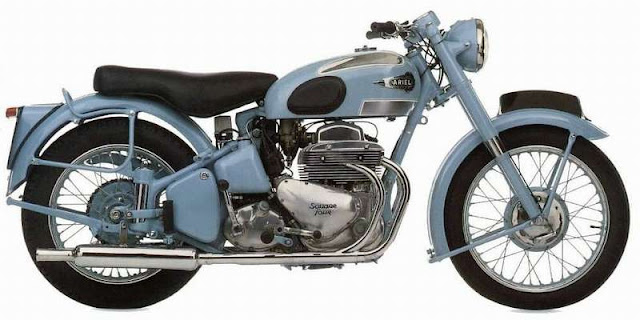Ariel Square Four
The Square Four 4G Mkl was a 997cc machine that provided plenty of smoothness and comfort, if not outstanding performance. This bike dates from 1952, the year before this model ‘Squariel’ was replaced by the Mkll version, which featured more power and improved cooling, and was distinguishable by its two pairs of exhaust downpipes.
‘Ten to a hundred in top gear’ was the proud boast that Ariel used in its IBtf advertising for the Square Four during the 1950s, emphasizing the machine’s low-rev refinement as well as its top speed of over 1 OOmph (161km/h). In fact, even the final version of the Square Four was not as fast as its impressive specification and high price suggested. It was more of a luxurious - if rather unreliable - grand tourer than a sports machine. But for many years Ariel’s flagship was one of the most glamorous bikes on the road.
The Square Four went through numerous redesigns during its long life, which lasted from 1931 to 1958. During that 27-year period, the Ariel’s engine capacity doubled, and its chassis and styling were transformed. Yet the air-cooled square four engine layout's advantages of power, smoothness and compact size remained throughout - as did its drawbacks of high production cost and the difficulty of providing sufficient cooling for the sheltered rear cylinders.
Legend has it that this most exotic of motorcycles was born after a gifted young engineer, Edward Turner, had drawn up a novel square four engine layout on the back of a cigarette packet and tried unsuccessfully to sell the idea to a succession of bike manufacturers. Turner, later to find lasting fame at Triumph, eventually convinced Ariel chief Jack Sangster that the square four concept was sound, and was hired to put it into production.
Turner’s design was basically a pair of parallel twins, sharing the same cylinder head, block and crankcase, with their crankshafts geared together. This gave a naturally smooth-running engine, and was so compact that the original 497cc unit could be fitted into a frame very similar to that of Ariel's current 500cc single. That first Square Four, introduced in 1931, featured a chain-driven overhead camshaft and exhaust manifolds integral with the cylinder head, so that only two exhaust pipes emerged from the engine. Turner’s original design had used an integral three-speed gearbox, but the production bike had chain primary drive to a separate four-speed Burman box.
After one year of production the engine was enlarged to 597cc, giving extra power that was particularly welcomed by sidecar owners. In this form the Square Four produced 24bhp at 6000rpm, and stayed smooth to its top speed of 85mph (137km/h). But the ‘Squariel’ suffered from cooling and other problems. In 1937, after Turner had left for Triumph, Ariel introduced revised 597cc and 997cc models, known as the 4F and 4G, designed by new chief engineer Val Page.
The new engines featured more cylinder head finning plus a tunnel between the cylinders to allow cooling air to the rear of the block. Other changes included pushrod valve operation and longer-stroke dimensions. The larger 4G produced 34bhp with plenty of low-down torque. But as well as some unreliability it also suffered from mediocre handling, being too heavy for the plunger rear suspension system that had been adopted along with telescopic forks.
In 1953 Ariel introduced an uprated version, the 4G Mkll. incorporating a new cylinder head complete with four instead of two downpipes. Cooling was improved by the air that now ran over the exhaust ports. Reshaped pistons helped raise power to 40bhp at 5000rpm, increasing top speed to over 105mph (169km/h). But Ariel never got round to introducing the liquid-cooled engine that might have solved the longstanding overheating problem for good.
The reason for lack of further development was simple: Ariel, by now part of the BSA group, had made its controversial decision to abandon four-stroke production in favour of the two-stroke Leader commuter bike. In 1958, the year the Leader was launched, the four-cylinder bike was dropped from the range, and an era that had lasted for almost 30 years came to an end. No rider who had experienced the Square Four’s unique blend of performance, smoothness and sophistication would forget it.
Handling of the plunger-framed Square Four 4G Mkl was not a strong point, partly due to the bike's substantial weight, but the Ariel provided a comfortable ride.
Twin downpipes gave the square four engine a deceptively ordinary look. Despite heavy finning, cooling of the rear cylinders remained a problem throughout the model’s life.
The Square Four’s good looks added to its glamour and appeal, and when the bike was running well there were few machines of the early 1950s that were more refined.
Specification Ariel Square Four 4G Mkl (1952)
- Engine Air-cooled ohv eight-valve pushrod square-four
- Capacity 997cc (65 x 75mm)
- Maximum power 34bhp @ 5400rpm
- Transmission Four-speed, chain final drive
- Frame Steel twin downtube
- Suspension Telescopic front; plunger rear
- Brakes Drum front and rear
- Weight 433lb (196kg)
- Top speed 100mph (161km/h)




















0 comments: